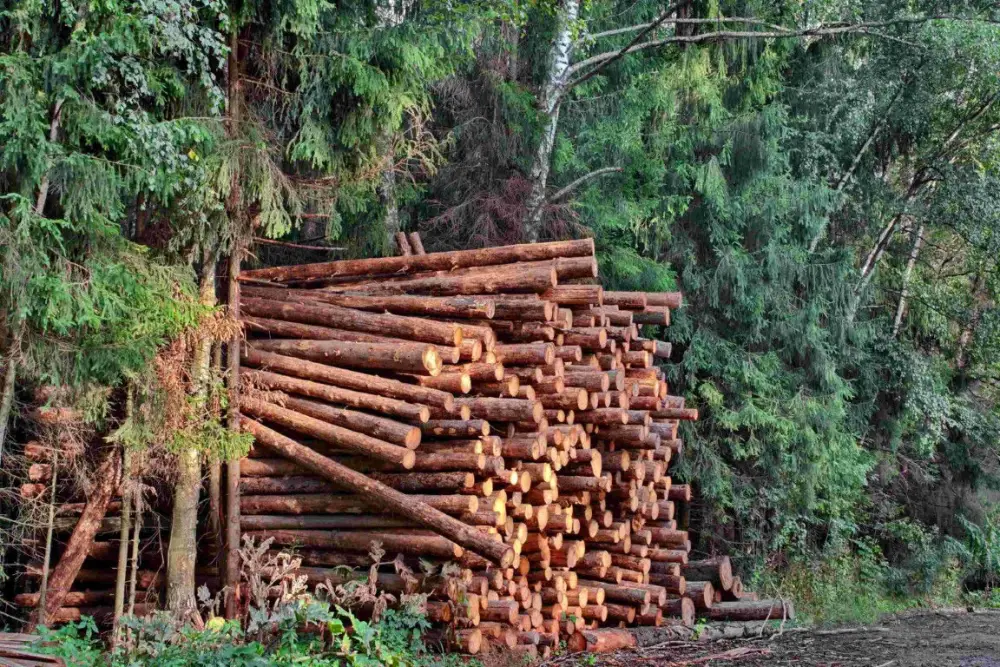Polish Forestry between Environmental Protection and Economic Growth
Editor WoodBusinessPortal.com team - research, 2025 - September, 9
Poland`s forestry sector plays a pivotal role in both environmental stewardship and economic development. As a major European wood producer and exporter, Poland exemplifies how sustainable forestry can coexist with industry growth. Below, we highlight key trends, forecasts, and market dynamics - relevant for wood-industry professionals.
Forest Resources & Environmental Oversight. Forests cover approximately 31 - 38% of Poland`s land area, with estimations pointing toward an increase to 42 - 46% by 2035, indicating a significant environmental expansion trend. The growing stock of standing wood at the end of 2022 totaled ~2.696 billion m³, with a net annual increment of 78 million m³ and removals of 55.8 million m³. The production value of forestry and logging in 2022 was PLN 36.6 billion, while the value of standing stock in forests available for supply reached PLN 549.3 billion.
These numbers reflect Poland`s robust forest capital and its responsible management that underpins sustainable supply.
Harvesting & Supply Dynamics. In 2022, 45.7 million m³ of roundwood was harvested - 6% more than in 2021 - but production wood (industrial use) rose only by 0.4%. Fuelwood represented the largest growth, increasing by 54%, primarily to meet individual heating demand. Softwood dominates removals (78%), while industrial assortments make up 85% (~38.7 million m³) of harvest. Forecasts suggest domestic harvesting may reach 48.6 million m³ by 2024, with production wood climbing to 40.9 million m³.
Trade: Imports, Exports & Market Shifts. Though domestic supply is substantial, imports surged by 25% in 2022 to ~3.8 million m³, largely industrial softwood (2.8 million m³). Hardwood imports also surged by 86%. Exports grew by 26% to 5.3 million m³, with industrial softwood accounting for 85% of the volume; Poland ranked 9th globally in industrial wood export share at 2.8%. The main export partner remains Germany, absorbing 29% of Poland`s industrial wood exports.
Looking ahead, imports are projected to rise to 4.1 million m³ in 2023 and 4.4 million m³ in 2024; exports to climb to 5.5 million m³ and 5.8 million m³ respectively.
Value-Added Products & Processing Trends. Sawn softwood production in 2022 totaled 4.1 million m³ (-9% vs. 2021). Imports of sawn softwood (~1.2 million m³) accounted for 29% of supply. Exports dropped 24% to ~0.7 million m³. Modest recovery is expected by 2024. Sawn hardwood production remained at ~0.5 million m³ in 2022. Imports fell by 14%; exports also slipped 10%. Forecasts point to higher import reliance (+12%) while exports remain flat.
Veneer sheet production dropped by 3% to 45,000 m³; imports remained double local output (~92,000 m³); exports at ~16,000 m³. Future imports are expected to stabilize at ~94–98 thousand m³.
Production of wood-based panels (particleboards, fibreboards, plywood) declined ~15% in 2022. However, a moderate rebound (~4%) is forecast by 2024. Imports and exports may stabilize or grow slightly.
Wood pulp production stands at ~1.7 million tonnes, with imports comprising 75% of domestic production (~1.3 million tonnes). Exports are minimal (~0.2 million tonnes). Annual volumes are expected to remain stable through 2024.
Market Pressures & Trends. The wood sector faces price and supply pressures. In 2024, Poland experienced one of the highest wood prices in the EU, production value shrank 6%, export value dropped 3%, and layoffs affected ~18,000 workers. In 2024–2025, exports declined by 6%, while imports rose by 10%, indicating tightening raw material conditions.
Policy uncertainties have raised concerns. For example, reducing timber supply by 2 million m³ in 2025 may cost the industry billions of PLN and jeopardize jobs. Industry stakeholders are actively pursuing strategic reforms.
Polish forestry offers a dynamic mix of abundant, sustainably managed resources and expanding international trade, underscored by supply shifts and market volatility. Key conclusions:
- Investment and planning should anticipate rising import reliance, especially for value-added assortments.
- Domestic producers are encouraged to enhance vertical integration, improve resource efficiency, and diversify product offerings.
- Keeping abreast of policy developments and supporting sustainable management will strengthen industry resilience.
Discover More! For comprehensive insights, market data, pricing trends, news, and strategic analysis for professionals in the wood industry, explore WoodBusinessPortal.com - your B2B gateway to timber trade, forestry economics, and industry foresight.
Sources:
1. wits.worldbank.org
2. unece.org
3. stat.gov.pl
4. en.wikipedia.org
